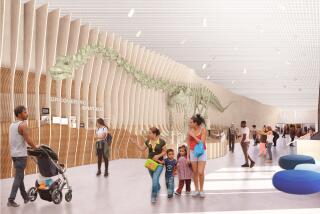Day of the ‘Dinosaur’
- Share via
Several leading paleontologists are gathering Sunday at the Natural History Museum of Los Angeles County for “Dinosaur Discoverers,” a five-hour-plus symposium focusing on recent discoveries in Mongolia, Patagonia, Montana and China of dinosaur eggs and embryos that have helped change perceptions of dinosaurs. The paleontologists involved in these discoveries will talk about their finds, including the largest dinosaur nesting site unearthed, as well as the first dinosaur embryos found.
The symposium is being held in conjunction with a current museum exhibit, “Tiniest Giants: Discovering Dinosaur Eggs.” Speakers include Luis M. Chiappe from the Natural History Museum; Roldolfo A. Coria from the Carmen Funes Municipal Museum in Argentina; Philip J. Currie from the Royal Tyrrell Museum of Palaeontology in Canada; and Frankie Jackson of the Museum of the Rockies, Montana State University.
Also featured on the panel is Lowell Dingus, a research associate at the American Museum of Natural History in New York and author of several books, including the recently published “Walking on Eggs: The Astonishing Discovery of Thousands of Dinosaur Eggs in the Badlands of Patagonia,” which he wrote with Chiappe.
Dingus recently talked about the symposium and new finds in the dinosaur world over the phone from his home in New York.
Question: What is your area of expertise in paleontology?
Answer: You can approach paleontology in two different perspectives. You can take a geological approach or a biological approach. If you study from a geological approach like I do, basically you are studying the age of the rock that contains the fossils and you’re studying the clues in the rocks that can lead you to interpretations about the environment that the animals were living in. If you are studying biological aspects of paleontology, you are dealing with more evolutionary relationships between the different kinds of dinosaurs and more about how their bodies function, what their behaviors were based on and how their skeletons were built.
I have done fieldwork in Montana as a student and also in Mongolia and China and with Luis [Chiappe] down in Argentina. It is a lot of fun, but it can get old at times when you have been out here a long time.
Q: What type of discoveries have you made?
A: I am not the ace fossil collector--that is not really my role. The kinds of discoveries that I have been part of really relate more to finding rocks that will give us clues about the age and the environment in which the animals lived.
Q: So what did you learn from the rocks in Argentina?
A: In Argentina, the dinosaur eggs seem to have been buried by flood debris when small streams that ran across the ancient flood plain would overflow their banks and dump a layer of silt and mud on top of the nests where the eggs had been laid.
*
Q: Why are these dinosaur eggs and embryos so well preserved?
A: The burial by flood debris really very quickly buried the eggs. There was apparently a lack of oxygen in the sediment that buried the eggs so the materials within the eggs didn’t decay very quickly, which probably helped a process of fossilization very shortly after they were buried. We don’t know a lot of environmental chemical details about how all of those processes operated. We are still studying that, but what is clear is that because of the floods, the debris very quickly buried the eggs, killed the embryos inside the eggs and helped preserve tissue and skin.
*
Q: Do a lot of youngsters come to these symposiums?
A: When I give public lectures like this, it is a lot of parents with kids. I suspect it is kind of their kids dragging their parents along to the symposium. Often during the question-and-answer sessions, it is the kids who will pipe right up and ask their questions, whereas the adults seem a little more reticent to expose themselves to asking what they may think is a stupid question. Oftentimes it is the kids who really jump right in and want to interact with you and get their questions answered.
*
Q: Why are more and more fossils being unearthed at the present time?
A: Because of the cultural popularity of paleontology, it’s a little bit easier to get funding to go out into the field. Certainly, there are a lot more people interested in doing that. The other reason is basically we are looking in areas that haven’t been explored. The countries in which we are looking now are just starting to get into scientific research either because they didn’t have the resources to do it before or they just haven’t had the people interested in going out.
*
Q: In “The Mistaken Extinction,” the 1997 book you wrote with Tim Rowe, you state that dinosaurs are still among us.
A: Did dinosaurs go extinct 65 million years ago? It is becoming more clear that they didn’t. Ninety-nine percent of the paleontologists in the world would agree birds evolved from little meat-eating dinosaurs. It is based on the skeletal similarities [between birds and dinosaurs] in the way their bones are shaped and built. You can follow the features you see in modern birds and you can follow the pattern of evolutionary development of these features way back into different groups of dinosaurs.
Q: So my old family parakeet Tweety is descended from dinosaurs?
A: He is not only descended from a dinosaur, he is a dinosaur.
*
* “Dinosaur Discoverers” symposium takes place Sunday from 1 to 6:30 p.m. in the Natural History Museum’s Jean Delacour Auditorium, 900 Exposition Blvd., L.A. $10; students, free. The “Tiniest Giants” exhibit continues through Oct. 14. Call (213) 763-DINO.
More to Read
The biggest entertainment stories
Get our big stories about Hollywood, film, television, music, arts, culture and more right in your inbox as soon as they publish.
You may occasionally receive promotional content from the Los Angeles Times.











